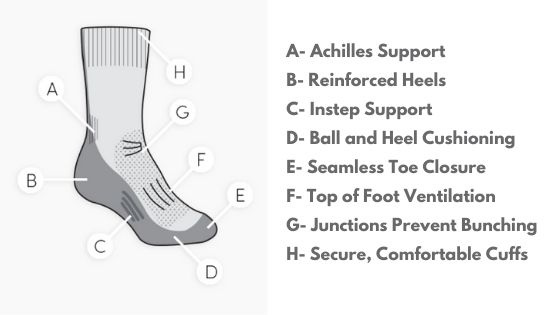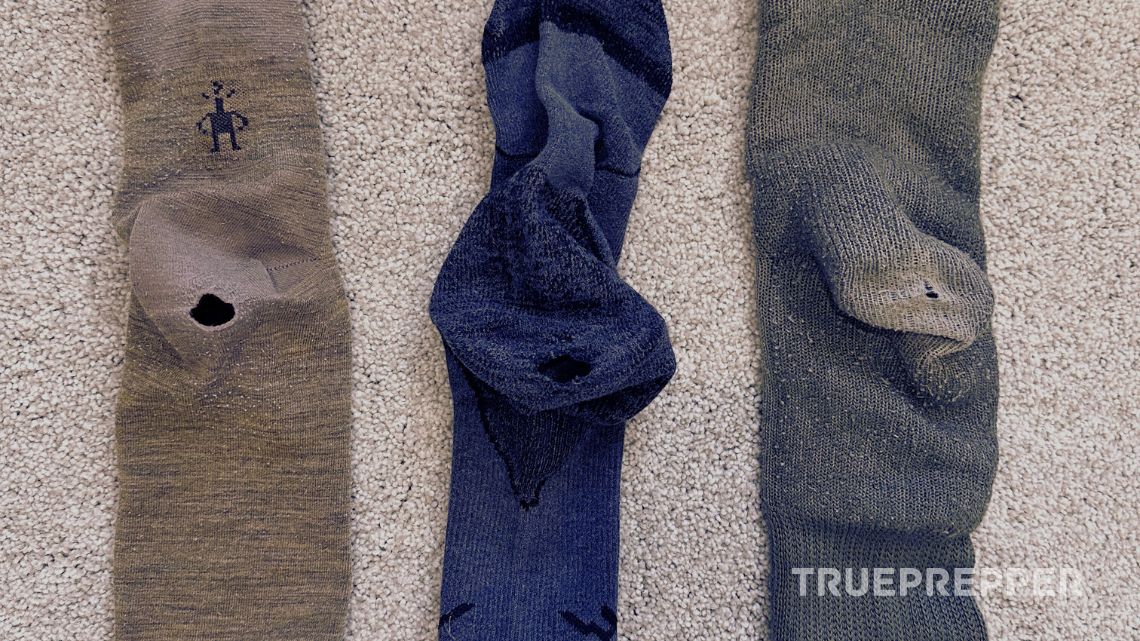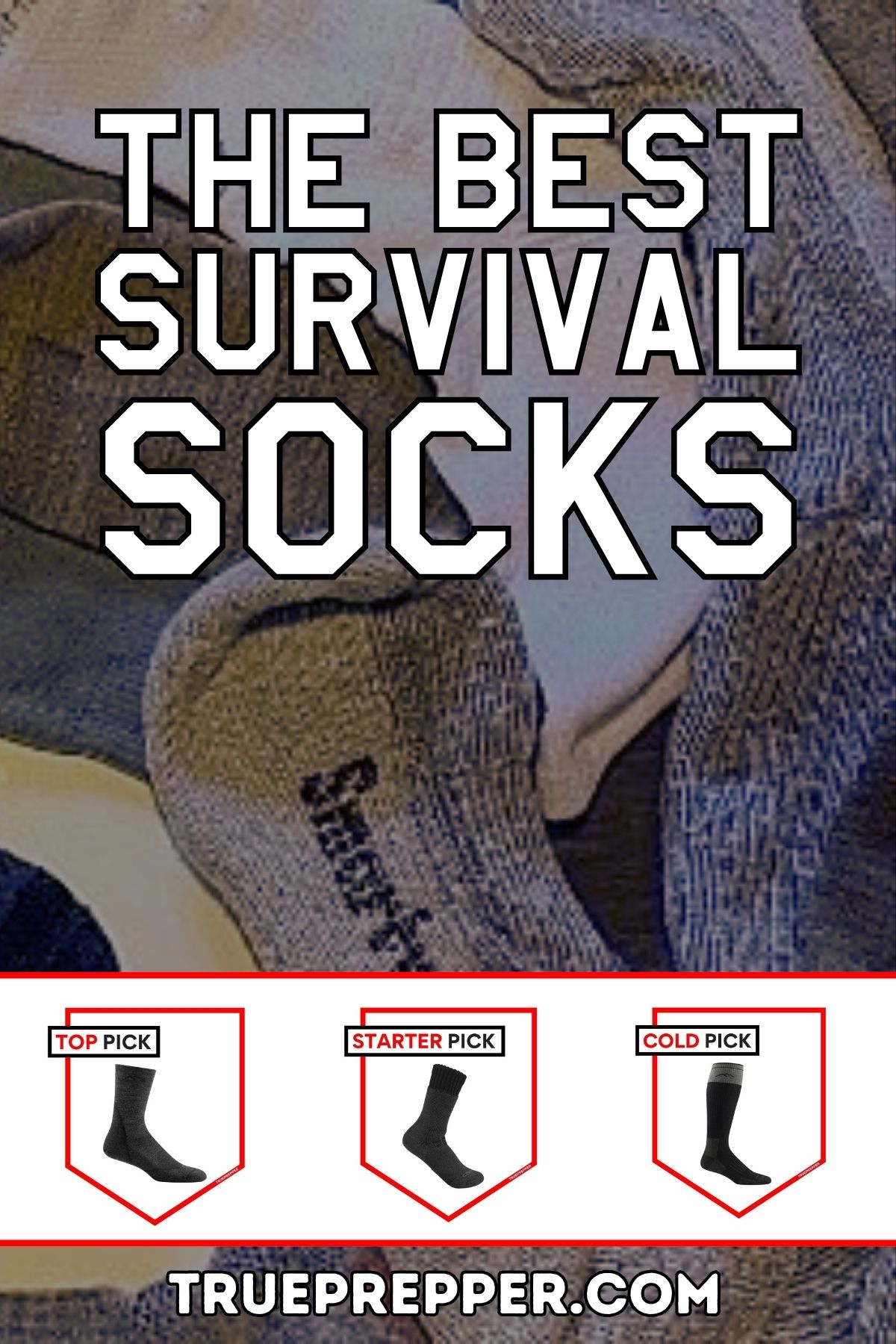Blisters, seam irritation, bunching, fungus, and even trench foot: all of these are what happens when you have a bad pair of socks. Even if you don’t experience any of these problems, poorly made socks wearing thin and developing holes is annoying. I’m not particularly tough on my feet, but I have worn holes through bad-quality socks in a matter of weeks. Nobody wants to be constantly shopping for socks. This is not something you want to deal with in a survival situation.
We’ve been researching this one for a while, testing a wide variety of socks to find the best suited for survival conditions. Hiking, military, and even big-box store socks made the initial cut. Durability, toughness, and comfort were all huge factors that separated the best socks from the rest of the field. We’re excited to share our findings and get everyone’s feet feeling great no matter which disaster or emergency they encounter. If you want comfortable, breathable, durable socks for any situation, one of our survival sock recommendations will accomplish that mission.
Contents (Jump to a Section)
The Best Survival Socks
Comfortable, Breathable, and Tough (of course)
These top-rated socks give you consistent quality and extreme durability.
*Price at time of publishing; check for price changes or sales.
You have probably heard of Darn Tough Hiker Socks. The Darn Tough company out of Vermont is well known for these socks, their durability, and the lifetime warranty they tack onto it. The socks we’ve selected are one of their lighter-weight options, which performed better in a wide range of climates and activities than the thicker options.
The socks are a synthetic blend: merino wool, nylon, and spandex. This makes for a sock that fits like a performance athletic sock but has the beneficial wool properties of a heavy hiking sock. The performance knit can feel tight on your foot at first, but the sock is seamless and holds its shape fantastically, making them very comfortable.
If you want the best survival socks, the Darn Tough Light Hiker Socks will get the job done better than the rest.
Budget Survival Socks
Padded comfort that won’t break budgets.
Stay on your feet longer with heel and toe padding that reduces pressure, blisters, and moisture.
*Price at time of publishing; check for price changes or sales.
Carhartt is a recognizable brand that is widely available at budget prices. Their composite boot socks have come a long way, and now include acrylic, wool, nylon, and spandex for a durable all-weather sock. They have lower wool content than some of our other top picks, which drastically lowers the price. Buying in bulk helps also. Even with their lower wool content, they stay surprisingly comfortable in a wide range of temperatures, and even in damp environments.
It is tough to beat the bulk price of these Carhartt wool composite socks if you are looking to stock up or upgrade your regular wardrobe. If you need socks to make a skivvy roll to keep in your bug out bag, the Carhartt Wool Blend Boot Socks will do the trick.
Cold Weather Survival Socks
Practical, comfortable, and toasty in cold weather.
These durable, heavy-weight socks are perfect for backwoods snowy hikes, or walking frigid city streets.
*Price at time of publishing; check for price changes or sales.
Cold weather is what these socks are about, and the Hunter extra-cushion over-calf socks are the most versatile pair you can get for extremely cold conditions. They are made from 79% Merino Wool, 19% Nylon, and 2% Elastane for a composition that gives great thermal properties with an exceptional fit. On many heavyweight socks with high-pile padding, you can experience slipping within the sock. These socks fit snugly to prevent this, with the help of the Elastane.
The top of the sock is designed to be breathable, which is often overlooked in extreme thermal socks. We found that socks that concentrate too much on heat retention with excessive thermal insulation become uncomfortable to wear in practical settings. Socks that do this, like Heat Holders, are meant for diabetic applications to improve circulation in your feet with heat.
Practical cold-weather survival socks balance thermal regulation with a snug, dry, comfortable fit. The Darn Tough Hunter Full Cushion Socks will do just that- and come with a lifetime no-questions-asked warranty to boot.
Everything We Recommend
The Socks We Compared
Our research narrowed the field down to several contenders that we tested: Thorlos, Darn Tough, SmartWool, Wrightsock, Under Armor, WigWam, Heat Holders, Icebreaker, J.B. Icelandic, Carhartt, Dickies, Hanes, and more. From there it came to just wearing the socks for extended periods, in a variety of activities, and seeing how they felt and held up. This helped us eliminate the socks that were too hot, shifted around, or had other comfort issues.
What to Look For
The best survival socks have several important features to look for:
- Composition
- Knit Shape and Features
- Padding
Below, we break down what each of these means for a great pair of survival socks. When you get the right blend of these, you get a versatile high-performance sock. You can also see variations of these three features to improve performance in different environments- like wet or extremely cold areas.
Survival Sock Composition
Socks have definitely become more complex over the years, especially with the many types of yarns now knitted into composite socks. Wool socks used to take the cake- there weren’t any comparable socks that could measure up to wool’s performance. Cotton stays damp and polyester provides very little thermal insulation.
Polyester wool blends are a prime marketing tactic used by some sock makers. Low wool content synthetic blend socks are still ‘wool socks’, and marketers have been known to abuse this. The difference between a 60% wool blend sock and a 20% wool blend sock is very noticeable, but the cost of the 60% wool blend is twice as much. Additionally, yarns such as acrylic and elastane can improve the durability and fit of a wool blend sock.
When a sock with solid yarn composition is combined with cutting-edge knit features, the sock simply performs better.
Knit Shape and Features
The knitting machines that create socks are complex, and huge, and have become more advanced over the years. This allows them to adjust the knit to create unique sock shapes not just for different sizes, but to concentrate different yarns in different areas adding features to some of the best survival socks.
These features can include:

Advancements in knitting technology have drastically improved sock features.
All of the knit features in the graphic above make a sock more durable, comfortable, and effective in any survival situation.
Sock Padding
Besides the yarn composition and the knit features, the amount of padding (or lack of padding) provided by the knit pile can affect a sock’s durability, comfort, and thermal insulation. Many hiking socks have more padding on the ball and foot of the sock, with less padding on top of the foot. Ski socks have padding on the shin, while snowboard socks do not. Steel toe socks have extra toe padding. Padding can be in different areas based on the purpose of the sock.
Padding can be more comfortable, but it can also cause the sock to be too hot if there is too much of it. Excessive padding (on a cotton sock, in particular) can make a sock hold water and sweat for much longer. High-pile padding can add a slipping sensation even if a shoe or boot is snug since the padding can allow the inside of the sock to shift compared to the outside of the sock.
The trick to sock padding is to have it in the correct locations- and not too much of it.
Why Socks are Important for Survival
Blisters, skin maceration, frostbite, and even trench foot can be preventable with the right equipment while taking care of your feet. Taking care of your feet includes keeping your feet:
Socks and shoes are the best equipment to do this reliably. Toe warmers and other technology are great but are temporary and/or cost-prohibitive to use all the time. The best practices you can use to protect your feet include:
- get several pairs of great socks
- use skincare products, like Gold Bond powder to keep your feet dry at the end of the day
- listen to your feet: itching, pain, and numbness can all be indications of trench foot
- wear some good shoes/boots that fit well
That last bullet is pretty important- a poor fit will wear down your socks quicker, even if they are made of thick, high-quality materials.

Poor-fitting boots can wear even high-quality socks quickly.
In a survival situation or emergency, the last thing you want to deal with is your everyday items and clothing failing you. Bad socks causing blisters (or worse) can hamper your ability to deal with much more important issues.
Who Needs Survival Socks?
Everyone wears socks, and everyone can benefit from high-performance socks that won’t let you down.
The main kits that you should have survival socks for include:
Survival socks also make sense as part of a skivvy roll in these kits:
A skivvy roll is a way to roll a shirt, underwear, and socks together for quick retrieval in a bag. You can find out more here: How to Pack Like a Pro: The Skivvy Roll.
How We Review Products: We research thoroughly before selecting the best products to review. We have vast prepping and survival experience and bring in outside experts when needed. Hours on end are spent testing gear in stressful conditions and using specialized testing gear to verify claims. We assign performance criteria and impartially rate each tested item. Learn more about how we test.
Sources and References
An objective look at the best survival socks is useless without sources and references. We leaned on these for the book knowledge that we paired with our practical military experience and prepping acumen.
Baird, K., et al. (1971). Wearing and Washing Performance of Wool/Nylon Blend Socks. Textile Research Journal. Volume 41. Issue 7. (Source).
Özdil, N. (2008). A Study on the Thermal Comfort Properties of Socks. Tekstil ve Konfeksiyon. Volume 18. Issue 2. Pages 154-158. (Source).
Richie, D. (2017). Athletic Footwear and Orthoses in Sports Medicine. Springer, Cham. (Source)
The Final Word
Being properly equipped to deal with any situation is no small task. Socks may seem inconsequential at first compared to skills, hobbies, and other equipment and resources- but hopefully, we’ve convinced you of how important a solid pair of socks can be. When I advise beginning preppers, I always explain how spending a little more on the stuff you use every day pays off in the long run. Wearing a rugged pair of socks doesn’t take any skill- just a little bit of forethought on a small detail that can affect your survivability.
I’m glad we picked survival socks to try out and test because I was able to try a lot of great socks myself and help figure out which socks were the best of the best. Now, I’m outfitted with the best socks for everyday use and for my skivvy rolls.
Here are some more reads our subscribers find useful:
We presented quite a lot of information, but as always: if you have any questions let us know and we would be happy to help. Our research and testing settled on Darn Tough Light Hiker Crew Socks as the best option given the functionality, durability, versatility, and value.
Most of the time, at this point I’m telling you to practice with your gear- but with socks… just wear them! And with the best socks, you don’t have to worry about wearing them out!
Keep exploring, stay prepared, and be safe.
You’ve Been Missing Out
Join the 2+ million preppers that rely on our prepping advice by subscribing to TruePrepper.
- Practical guides and tips
- Useful survival giveaways
- Free, forever
- < 0.4% of people unsubscribe
Thanks for subscribing, reading, and welcome to the club.

The post Best Survival Socks for Preppers and Survivalists appeared first on TruePrepper.
https://trueprepper.com/best-survival-socks/
 CampingSurvivalistHuntingFishingExploringHikingPrivacy PolicyTerms And Conditions
CampingSurvivalistHuntingFishingExploringHikingPrivacy PolicyTerms And Conditions
